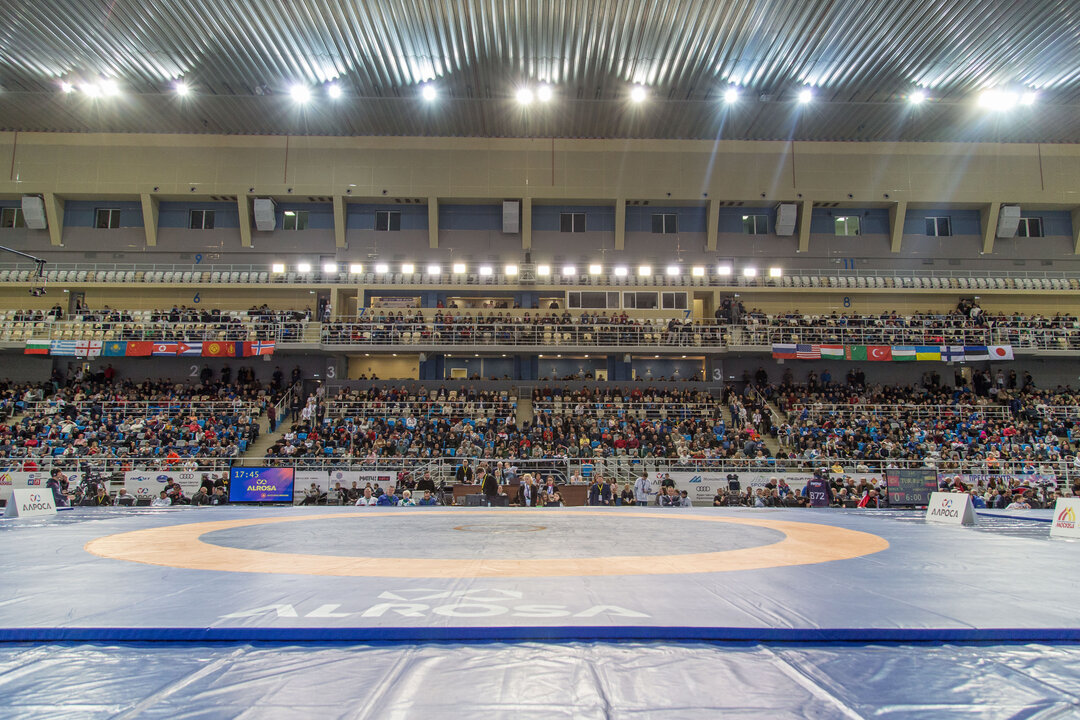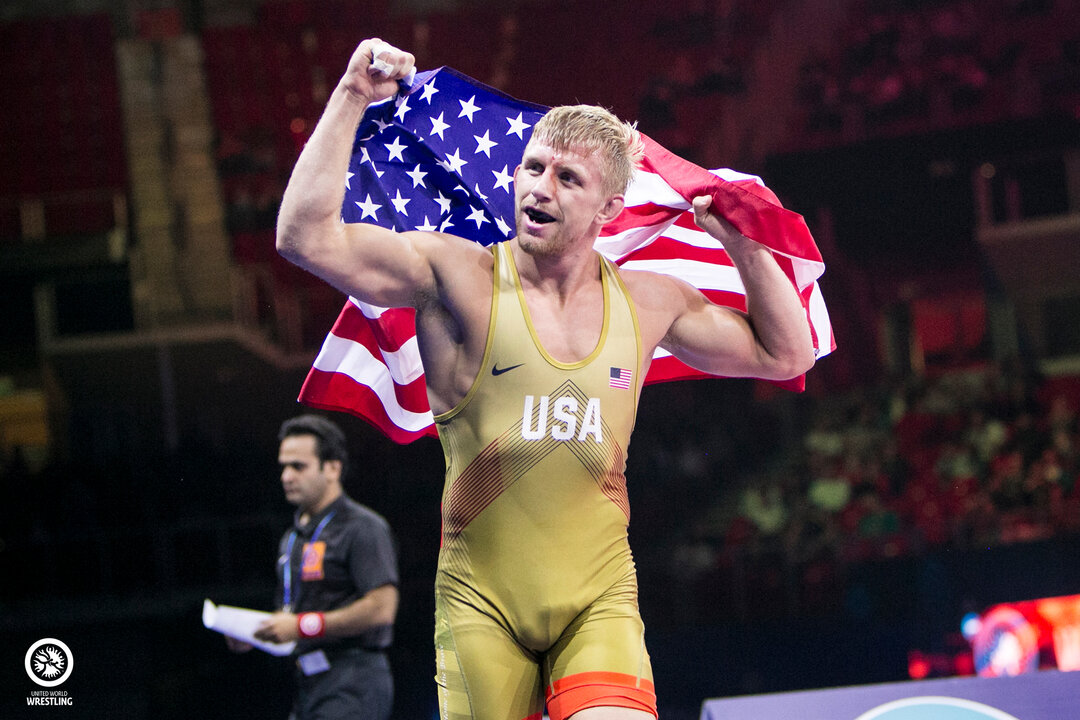5 رویداد برتر هفته - 5 نوامبر 2018
دوشنبه, نوامبر 12, 2018 - 11:11 By Eric Olanowski

مرور مسابقات لیگ کشتی آزاد ایران و همچنین آمریکا و نگاهی به فرآیند مسابقات انتخابی برای جام یاریگین
1- قهرمانی بیمه در لیگ کشتی آزاد ایران به کمک گاژی ماگومدوف، کریمی و قربانعلی یف
تیم بیمه رازی با استفاده از ستارگان کشتی روسیه و ایران توانست به پیروزی 26-15 در مصاف با ستارگان ساری برسد و قهرمان لیگ کشتی آزاد ایران شود.
تیم ستارگان مسابقه فینال را با دو پیروزی پشت سر هم توسط نادر حاج آقانیا در 57 و مهران شیخی در 61 کیلوگرم بدست آورد. پس از پیروزی 5-3 حاج آقانیا در 57 کیلوگرم، شیخی توانست بهنام احسانپور قهرمان و نایب قهرمان سه دوره آسیا را با نتیجه 5-2 از پیش رو بردارد.
در ادامه، میثم نصیری قهرمان 2016 آسیا فرزاد عموزاد را 6-2 مغلوب کرد تا اولین برد نصیب تیم بیمه شود. ماگومد قربان علی یف قهرمان سال 2016 جهان که یکی از سه کشتی گیر روس تیم بیمه بود، به پیروزی با امتیاز عالی 15 -4 مقابل یگانه جعفری در 70 کیلوگرم رسید تا دومین برد را برای تیمش بدست آورد.
در مسابقه پنجم این حسین الیاسی بود که امیدهای تیم ساری را زنده نگه داشت و با پیروزی 6-4 مقابل رضا افضلی، تساوی 2-2 را به برتری 3-2 به سود تیم ساری تغییر داد.
اما در وزن 79 کیلوگرم احمد گاژی ماگومدوف ملی پوش روسیه و برنده مدال برنز 2018 جهان فریبرز بابایی را با شکست 10-0 بدرقه کرد تا دو تیم به تساوی در عدد 3 برسند.
علیرضا کریمی نیز که در مسابقات جهانی در وزن 92 کیلوگرم صاحب مدال برنز شد، در این مسابقات در وزن 86 کیلوگرم به روی تشک رفت که مقابل مسعود مددی به پیروزی با ضربه فنی رسید تا تیمش برای اولین بار در مسابقه فینال از لحاظ بردهای انفرادی پیش بیفتد.
محمد جواد ابراهیمی قهرمان سال 2018 آسیا نیز در مصاف با سینا غلامی در وزن 92 کیلوگرم کار آسانی داشت و او را 8-3 شکست داد. سپس ولادیسلاو بایتسائف قهرمان 2018 اروپا با پیروزی 6-0 مقابل امیر محمدی ملی پوش ایران در مسابقات جهانی 2017 پاریس، قهرمانی تیم بیمه در مسابقه فینال را تضمین کرد.
در سنگین وزن جابر صادق زاده قهرمان سابق جوانان جهان از تیم ساری برابر عباس فروتن به برتری 8-7 رسید اما این برد برای تیمش بی فایده بود و بیمه رازی با امتیاز مثبت 26-15 ستارگان ساری را مغلوب کرد تا صاحب جام قهرمانی لیگ کشتی آزاد ایران در سال 2018 شود.
دیدار فینال: بیمه رازی بابل امتیاز مثبت ۲۶ و برد انفرادی ۶ - پاس ستارگان ساری امتیاز مثبت ۱۵ و برد انفرادی ۴
(اسامی تیم ساری در ابتدا آمده است):
۵۷ کیلوگرم: نادر حاج آقا نیا، برنده – مهران رضا زاده (۵- ۳)
۶۱ کیلوگرم: مهران شیخی، برنده – بهنام احسان پور (۵- ۲)
۶۵ کیلوگرم: فرزاد عموزاد خلیلی – میثم نصیری، برنده (۲- ۶)
۷۰ کیلوگرم: مهدی یگانه جعفری – ماگومد قربان علی اف، برنده (۴- ۱۵)
۷۴ کیلوگرم: حسین الیاسی، برنده – رضا افضلی (۶- ۴)
۷۹ کیلوگرم: فریبرز بابایی – احمد گاژیماگمدوف (صفر- ۱۰)
۸۶ کیلوگرم: مسعود مددی – علیرضا کریمی، برنده (۱- ۹ ضربه فنی)
۹۲ کیلوگرم: سینا غلامی – محمدجواد ابراهیمی، برنده (۳- ۸)
۹۷ کیلوگرم: امیر محمدی – ولادیسلاو بایتسایف، برنده (صفر- ۶)
۱۲۵ کیلوگرم: جابر صادق زاده، برنده – عباس فروتن (۸- ۷)

2- پیوستن اتحادیه جهانی کشتی به طرح ابتکاری صلح جهانی فدراسیون جهانی تکواندو
اتحادیه جهانی کشتی به بنیاد بشردوستانه تکواندو که توسط فدراسیون جهانی تکواندو راه اندازی شده، پیوست و در این رابطه تفاهم نامه ای برای ترویج اقدامات بشردوستانه، صلح و اقدامات توسعه ای و حمایتی در سراسر جهان امضا کرد.
نناد لالوویچ رئیس اتحادیه جهانی کشتی و چونگ وون چو رئیس فدراسیون جهانی تکواندو در جریان مسابقات جهانی کشتی در بوداپست با یکدیگر دیدار کردند و این تفاهم نامه را به امضا رساندند.
نناد لالوویچ در این باره گفت: " ما از توسعه این اقدام انساندوستانه پیروی خواهیم کرد و با پیوستن به اقدامات فدراسیون جهانی تکواندو در ایجاد فرصت های متنوع برای ورزشکاران در کمپ ها، دستاوردهای این کار را خواهیم دید. مطمئنیم که کشتی و تکواندو به زندگی کودکان در کمپهای پناهندگان نور و روشنایی خواهند بخشید."
این توافق شامل همکاری کامل و تبادل اطلاعات بین سه سازمان می شود. هدف آنها تحقق همکاریهای نزدیک در موارد زیر است:
ترویج ورزش به عنوان یک وسیله قدرتمند برای ایجاد صلح، توسعه اجتماعی و یکپارچه سازی جمعیت های آسیب پذیر؛
اتحاد نیروها در ارائه ورزش برای توسعه و اقدامات صلح آمیز، بویژه در آکادمی تکواندو در کمپ پناهندگان Azraq در اردن و همچنین سایر نقاط بالقوه در سراسر جهان؛
تبادل و اشتراک گذاری تخصص، دانش، اطلاعات و انتشارات.
 Photo from Max Rose-Fyne of the 2018 Ivan Yarygin competition venue.
Photo from Max Rose-Fyne of the 2018 Ivan Yarygin competition venue.
3- اعلام فرایند راه یابی به جام ایوان یاریگین روسیه
بهترین کشتی گیران روسیه به ولادی قفقاز در اوستیای روسیه می روند تا در مسابقات Alans 2018 شرکت کنند تا شانس خود را برای راه یابی به جام ایوان یاریگین و حضور در کراسنویارسک در ماه ژانویه بسنجند؛ مسابقاتی که گفته می شود سخت ترین تورنمنت جهان است.
تنها کشتی گیرانی که از جام Alans معاف شده اند، ماگومد رسول گازی ماگومداف، عبدالرشید سعدالله یف، زائوربک سیداکوف و زائور اوگویف هستند که همگی در مسابقات جهانی 2018 صاحب مدال طلا شدند.
در هر وزن تنها سه کشتی گیر روسی جواز حضور در جام یاریگین را دارند.
 df. Jabrayil HASANOV (AZE) -4.jpg) Kyle DAKE (USA) carries the American flag after winning his first world title. (Photo by Max Rose-Fyne)
Kyle DAKE (USA) carries the American flag after winning his first world title. (Photo by Max Rose-Fyne)
4- مسابقه تیمهای "تیلور و دیک" دو قهرمان جهان در مسابقه ای تحت عنوان “American Wrestling League I The Beginning”
دیوید تیلور و کایل دیک دو قهرمان کشتی آزاد جهان از آمریکا تیمهای خود را برای مسابقاتی موسوم به “American Wrestling League I The Beginning” انتخاب کردند. این رقابتها در سلوار سنتر در شهر سیدار رپیدز در ایالت آیوا در تاریخ 30 نوامبر برگزار می شود.
شنبه شب تنها 10 مسابقه برگزار می شود که این دو قهرمان جهان هر کدام 10 کشتی گیر اصلی و 10 ذخیره را برای مبارزه در 10 وزن بین المللی انتخاب کرده اند.
هر کشتی گیری که در این مسابقه شرکت می کند، 2500 دلار و فرد برنده 5000 دلار دریافت می کنند.
تیم کایل دیک:
57 کیلوگرم: زاک ساندرز و آلن واترز
61 کیلوگرم: تونی راموس و نیک سیمونس
65 کیلوگرم: جردن اولیور و جاش کیندیگ
70 کیلوگرم: جیمز گرین و فرانک مولینارو
74 کیلوگرم: ایسایاه مارتینز و ریچی لوییش
79 کیلوگرم: نیت جکسون و جاش اسپر
86 کیلوگرم: نیک هفلین و پت داونی
92 کیلوگرم: هیدن زیلمر و درون وین
97 کیلوگرم: جیکوب کسپر و سرون فرانسیسکو
130 کیلوگرم: دوم بردلی و سرون فرانسیسکو
تیم دیوید تیلور:
57 کیلوگرم: نیکو مگالودیس و فرانک پرلی
61 کیلوگرم: کوری کلارک و برایس مردیت
65 کیلوگرم: زین رترفورد و اوان هندرسون
70 کیلوگرم: برندون سورنسن و آنتونی کولیکا
74 کیلوگرم: تامی جنت و جوی لاوالی
79 کیلوگرم: الکس دیرینگر و دان والیمونت
86 کیلوگرم: سامی بروکس و برت پفار
92 کیلوگرم: میشل ماچیاولو و بن پرووایزر
97 کیلوگرم: کیون گدسون و بلیز کابل
130 کیلوگرم: آدام کون و رابی اسمیت
5- آغاز مسابقات جهانی زیر 23 سال از 12 نوامبر
هفته آینده سالن پلی ولنت در بخارست رومانی میزبان مسابقات جهانی 2018 زیر 23 سال جهان خواهد بود. مسابقات کشتی از دوشنبه 12 نوامبر آغاز می شود.
رقابتهای جهانی با مسابقات فرنگی آغاز می شود، در ادامه مسابقات زنان خواهد بود و سپس رقابتهای آزاد برگزار می شود.
Click here for the full schedule.
5 رویداد برتر در شبکه های اجتماعی
1. Big Move Monday! #grecoromanwrestling #olympic #wrestling#activewrestling #5pointsthrow
#budawrestle2018
2. Nice action in 82kg Peter Bácsi two times World Champion,2018 Budapest #grecoromanwrestling #olympicwrestling
@unitedworldwrestling
3. ? #Budawrestle2018
4. Russia's U23 world squad.
5. Kyle Dake and David Taylor AWL draft picks






Share your thoughts.
دیدگاهها